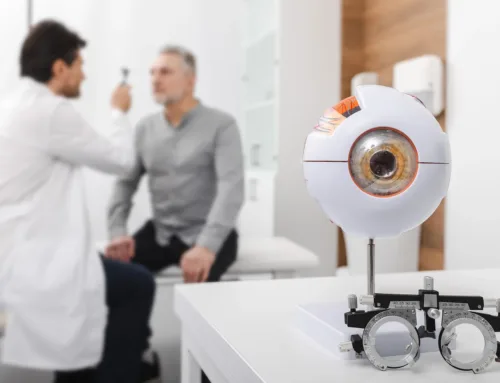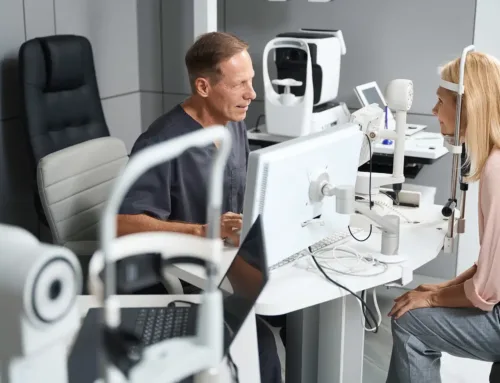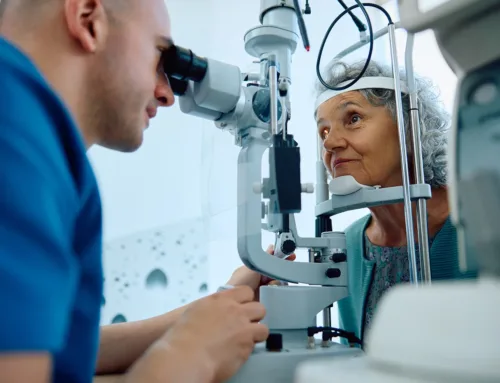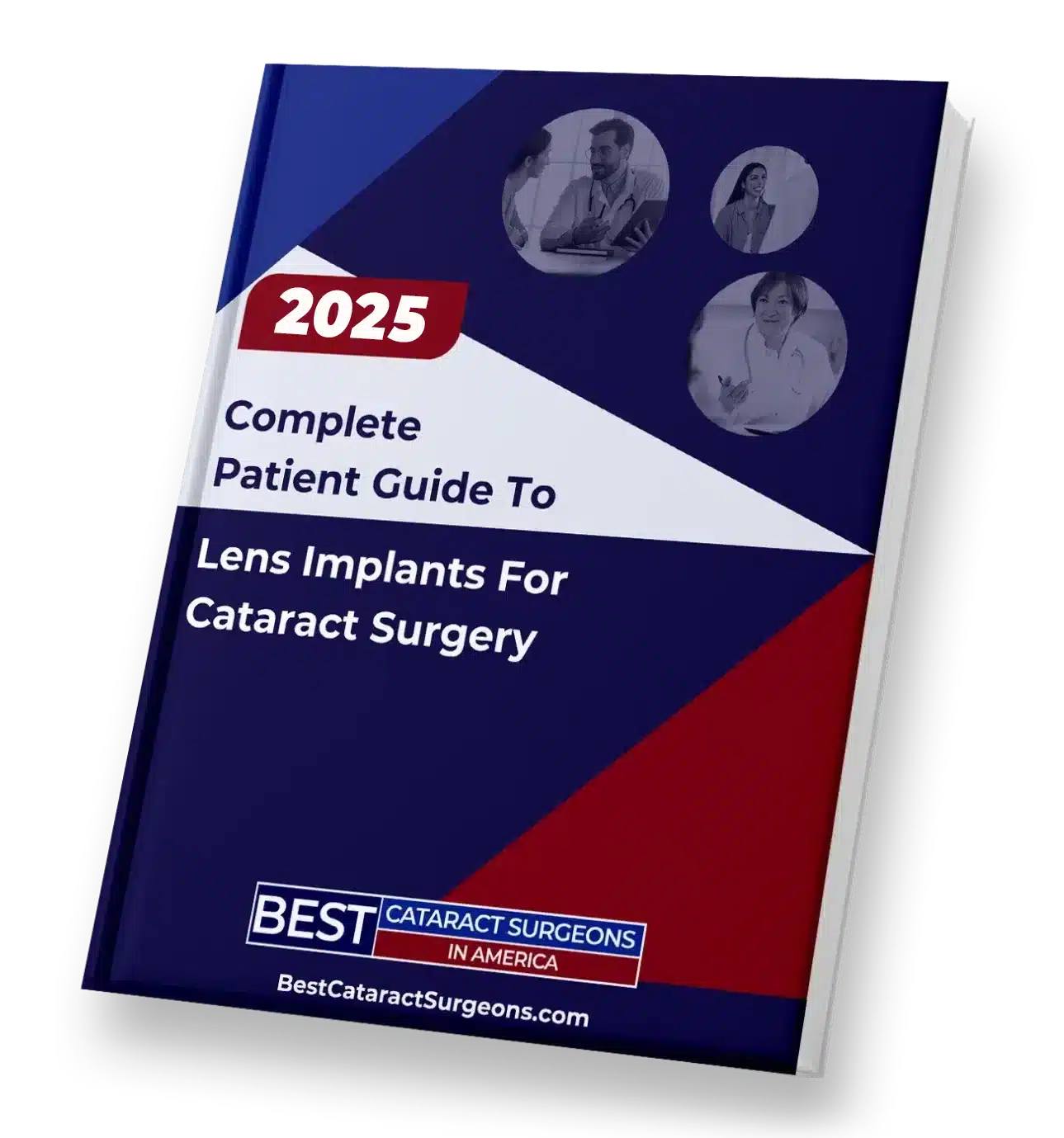Cataract symptoms are caused by a clouding of the natural lens. Cataracts are a leading cause of vision impairment globally, affecting millions of people each year. Despite being commonly associated with aging, cataracts can stem from a variety of risk factors and manifest in multiple ways, impacting daily life significantly. Understanding the symptoms of cataracts is crucial for early detection and treatment, which can restore vision and improve quality of life.
This comprehensive guide will help you understand the symptoms of cataracts, including early signs, risk factors and treatment options.
Before understanding the symptoms, you need to know what a cataract is!
In order to understand the symptoms of cataracts, you need to know what they are. A cataract is a common eye condition where the natural lens of the eye becomes cloudy, leading to a decrease in vision.
It often develops with aging and can affect one or both eyes. Cataracts are treatable, commonly through surgical removal of the cloudy lens and replacement with an artificial one, restoring clear vision.
Risks Factors for Development of Cataracts
Cataracts develop when the lens of the eye, responsible for focusing light on the retina to produce clear images, becomes clouded. Several risk factors contribute to causing cataracts, including:
- Age: The primary risk factor, with most cases occurring in people over the age of 60.
- Diabetes: High blood sugar levels can alter the eye’s lens, increasing cataract risk.
- Excessive Sunlight Exposure: Ultraviolet (UV) light from the sun can damage the lens.
- Smoking: Tobacco use accelerates lens damage.
- Alcohol Consumption: Excessive alcohol intake is linked to cataract formation.
- Previous Eye Injury or Surgery: Injuries or surgeries can lead to secondary cataracts.
- Use of Certain Medications: Particularly steroids, which can promote cataract development.
- Family History: Genetics play a role, with a higher risk among those with a family history of cataracts.
What are the Symptoms of Cataracts?
Cataract symptoms can vary depending on the type, location, and severity of the lens clouding. Common cataract symptoms include:
Glare
Increased sensitivity to light and glare, especially at night, can indicate cataracts. Bright lights may seem overwhelming or cause a halo effect.
Glare symptoms can be split into two types:
- Halos
- Starbursts
Halos are when rings appear around bright lights. If you’re driving at nighttime and see a rind of light around headlights, that would be a halo.
Starbursts are described as streaks of light emanating from a source. Instead of appearing as a ring, starbursts would appear as single or multiple streaks of light.
Blurry Vision
One of the earliest signs of cataracts is a general blur or cloudiness in vision, making it hard to see details. The cataract is like a cloudy lens that blocks and scatters light entering the eye. This results in the image being focused on the retina being blurry.
Double Vision
Cataracts can cause double vision (diplopia) in one eye, a symptom that should not be ignored.
Double vision can be serious, and even life-threatening. If you have double vision, it is important to contact a doctor immediately.
Reduced Contrast Sensitivity
Reduced contrast sensitivity is a less commonly discussed but equally impactful symptom of cataracts. This condition refers to the eye’s diminished ability to distinguish between variations in light and dark or between different shades of the same color.
Essentially, contrast sensitivity is crucial for performing tasks that require the ability to perceive subtle differences in brightness or color, such as driving at night, reading in low light, or recognizing faces.
Myopic Shift
A myopic shift, often associated with the progression of cataracts, refers to a change in the eye’s refractive state, resulting in increased nearsightedness. This shift occurs as the cataract alters the lens’s shape and increases its refractive power.
Individuals may notice a gradual improvement in their near vision, while their distance vision deteriorates. This phenomenon can be particularly perplexing and may lead to challenges in activities that require sharp distance vision, such as driving or recognizing faces from afar..
Change in Prescription
As cataracts grow, they may change the shape of the natural lens. This results in the prescription of the eye changing. Frequent changes in eyeglass or contact lens prescriptions may be a symptom for cataracts.
Change in Color Vision
Cataracts can make colors appear faded or yellowish, affecting how individuals perceive their surroundings. This is particularly bothersome for individuals who require discernment of color important, such as artists and photographers.
What are the Earliest Cataract Symptoms?
Different patients become bothered by different symptoms of cataracts. One of the most common early symptoms is difficulty driving at night due to glare. However, for other patients, they notice the continual change in their glasses prescription or change in colors first. Whenever you notice any of these changes to your vision, it’s important to see an eye doctor to make sure you have an accurate and prompt diagnosis.
How Are Vision Symptoms Caused by Cataracts?
Cataracts cause vision symptoms by interfering with the passage of light through the natural lens. The lens’s cloudiness scatters light as it enters the eye, preventing a sharp, clear image from forming on the retina. This process can lead to various visual symptoms, affecting one’s ability to see clearly and perform daily activities.
How to Tell if Your Symptoms Are Caused by Cataracts
The only way to know for sure if your symptoms are being caused by cataracts is to have a comprehensive eye exam. There are many other causes for blurry vision, glare, and other cataract symptoms.
If you’re experiencing any of the above symptoms, it’s essential to consult an eye care professional. They can perform comprehensive eye exams to determine if cataracts are the cause of your vision issues.
What Other Conditions Can Cause Cataract Symptoms?
Other eye conditions can cause symptoms similar to cataract. It’s important to have an eye exam to get an accurate diagnosis. Let’s discuss some conditions that can cause vision symptoms similar to cataracts.
Dry Eyes
Dry eyes can mimic cataract symptoms like blurred vision and sensitivity to light, as both conditions disrupt the eye’s ability to maintain clear, comfortable vision. The tear film is affected when the eyes become dry, leading to visual disturbances that can resemble the blurring and glare issues commonly associated with cataracts.
Macular Degeneration
Glaucoma
Many patients confuse glaucoma and cataracts. Glaucoma typically leads to peripheral vision loss, and does not cause the glare and halo symptoms of cataracts. However, glaucoma can cause reduced contrast sensitivity, similar to cataracts.
Secondary Cataracts
Different Types of Cataracts Cause Different Symptoms
There are different types of cataracts, including nuclear, cortical, and posterior subcapsular cataracts, each presenting with unique symptoms.
Symptoms of Nuclear Sclerotic Cataracts
Nuclear Sclerotic Cataracts are the most common type, typically associated with aging. These cataracts form in the center of the lens and gradually progress, causing the nucleus of the lens to harden and become more opaque. Initially, individuals may notice a myopic shift, leading to temporary improvement in their reading vision, often referred to as “second sight.” However, as the cataract develops, the lens turns yellow or even brown, significantly reducing color perception and clarity of vision. This type of cataract progresses slowly, often taking years to develop fully.
Symptoms of Cortical Cataracts
Cortical cataracts form in the lens cortex and extend towards the center in a spoke-like fashion. This type is characterized by white, wedge-shaped streaks on the outer edge of the lens cortex. Symptoms include problems with glare and a significant reduction in contrast sensitivity, making it challenging to discern shapes against a background or in dim lighting. Individuals might also experience difficulty driving at night due to the streaks distorting light. Unlike Nuclear Sclerotic Cataracts, the symptoms of Cortical Cataracts can interfere more abruptly with daily life.
Symptoms of Posterior Subcapsular Cataracts
Posterior subcapsular cataracts start at the back of the lens, right in the path of light on its way to the retina. This location means that even small cataracts can have a significant effect on vision. Symptoms include a marked decrease in vision in bright light, difficulty reading due to reduced light reaching the retina, and trouble seeing at night. This type of cataract tends to develop more quickly than the others and is particularly troublesome for people who use their near vision a lot, such as those who read frequently or work on computers.
What to Do if You Have Symptoms of Cataracts?
If you suspect you have cataract symptoms, the first step is to schedule an eye examination. Early detection is key to managing the condition effectively.
If your cataract symptoms are mild, it’s possible that changing your prescription of glasses or contact lenses may improve your vision.
However, cataracts only grow in one direction. That is, they will continue to gradually worsen, and surgery will become increasingly necessary if you wait long enough. Cataracts can eventually progress to legally blind vision if you wait too long.
How Are Cataract Symptoms Treated?
Treatment for cataract symptoms varies based on the severity of the condition and how they impact your daily activities. Some patients are bothered by cataract symptoms earlier than others.
When cataracts significantly impair vision, surgery is the most effective treatment. Modern cataract surgery can be performed with a laser. Cataract surgery involves removing the cloudy lens and replacing it with an artificial lens implant, restoring clear vision for most individuals. There are many different lens implant options for cataract surgery. These implants can provide distance vision, near vision, or both.
When To See A Cataract Surgeon
Consulting a cataract surgeon is advisable when cataract symptoms interfere with daily activities or if you’re diagnosed with cataracts. An eye care professional can recommend when surgery is needed based on your specific condition and vision needs. Visit our Directory to find a cataract surgeon near you.
Summary
Cataracts are a common condition that can significantly affect vision and quality of life. Cataract surgery is the most common surgery in the United States.
Recognizing the symptoms of cataracts, such as glare, blurry vision, and changes in color vision, is crucial for early detection and treatment.










